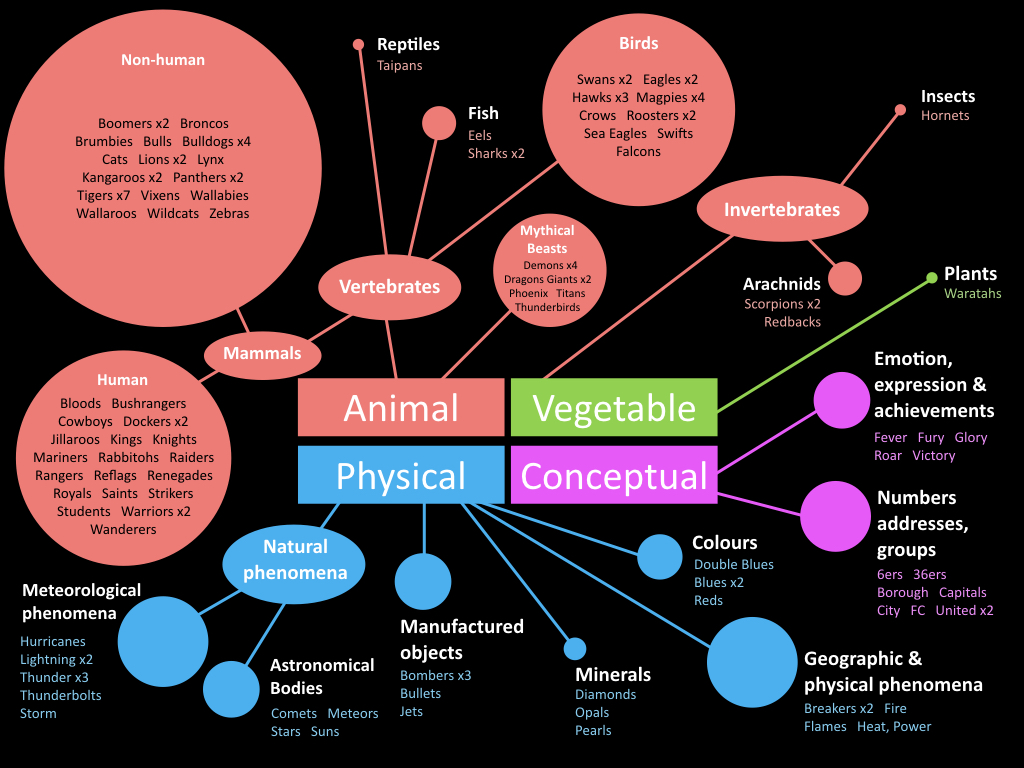Sports Taxonomy
 Tuesday, September 26, 2017 at 05:52AM
Tuesday, September 26, 2017 at 05:52AM Every day, across the globe, thousands of sporting teams take to the field, court, arena or course to compete in their chosen athletic pursuit. They have uniforms, mottos and songs, and they have names, nicknames or monikers. The Chargers, the Eagles, The Bears, the Flames, the 49ers. At first glance (in Australia at least) there seemed to be a preponderance of animal names, but which animals, from what classes, phyla and families? I crunched some numbers to find out.

I explored a random selection of professional and semi-professional Australian sports teams from a range of sports (cricket, rugby union, rugby league, basketball, Australian Rules Football, soccer and netball) and my assumption that most teams have animal names was correct, but this was not as dominant a feature as I had expected. The graphic above shows how things panned out, beginning with a simple classification as Animal, Vegetable, Physical or Conceptual.
There are some repeated names (seven ‘Tigers’ and four Magpies for example), but notwithstanding that feature, about 21% of the names were non-human mammals; 16% were humans (e.g. Cowboys, Bushrangers, Wanderers); 13% were birds. Interestingly 8% were mythical creatures such as Dragons, Phoenix and Giants.
There were no amphibians and very few reptiles or insects. There were some arachnids (spiders and scorpions), but no marine mammals (although I note that the Frankston Dolphins will return to the Victorian Football League in 2018). Only one team has a plant-inspired name – the Waratahs. It seems that with a slightly broader-minded or more imaginative approach, there are plenty of options available in the biosphere. Conifers, algae (the Kingston Kelp, anyone?), bacteria, epiphytes, marine invertebrates (perhaps the Sea Haven Sea Stars or the Central Coast Krill) and fungi to suggest a few. There are also biological phenomena that might be fun to see. The Evolution, the Plague, maybe even the Mutants.
In my sample, meteorological phenomena represent 5% of team names (e.g Hurricanes, Lightning, Thunder) and numbers, addresses and groups make up similar proportion (City, Capitals, 36ers). Astronomical bodies, such as Meteors, Comets and Suns make up just over 3%.
Of course this is only a small data set and there are loads of amateur clubs that I have not considered (yet), but I now have a greater appreciation of what’s out there and what could be.
References (6)
-
 Response: SPORTSEach game is sorted by the degree of power (low, medium, high) of dynamic or static activity for the most part expected to play out that game during contest.
Response: SPORTSEach game is sorted by the degree of power (low, medium, high) of dynamic or static activity for the most part expected to play out that game during contest. -
 Response: Online Shopping Stores
Response: Online Shopping Stores -
 Response: apple and cinnamon fragrance oil
Response: apple and cinnamon fragrance oil -
 Response: affordable climate control
Response: affordable climate control -
 Response: Budget University Online
Response: Budget University Online -
 Response: Best Performance T-shirt
Response: Best Performance T-shirt

Reader Comments